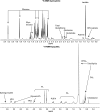Metabolic consequences of sepsis-induced acute lung injury revealed by plasma ¹H-nuclear magnetic resonance quantitative metabolomics and computational analysis
- PMID: 20889676
- PMCID: PMC3023293
- DOI: 10.1152/ajplung.00231.2010
Metabolic consequences of sepsis-induced acute lung injury revealed by plasma ¹H-nuclear magnetic resonance quantitative metabolomics and computational analysis
Abstract
Metabolomics is an emerging component of systems biology that may be a viable strategy for the identification and validation of physiologically relevant biomarkers. Nuclear magnetic resonance (NMR) spectroscopy allows for establishing quantitative data sets for multiple endogenous metabolites without preconception. Sepsis-induced acute lung injury (ALI) is a complex and serious illness associated with high morbidity and mortality for which there is presently no effective pharmacotherapy. The goal of this study was to apply ¹H-NMR based quantitative metabolomics with subsequent computational analysis to begin working towards elucidating the plasma metabolic changes associated with sepsis-induced ALI. To this end, this pilot study generated quantitative data sets that revealed differences between patients with ALI and healthy subjects in the level of the following metabolites: total glutathione, adenosine, phosphatidylserine, and sphingomyelin. Moreover, myoinositol levels were associated with acute physiology scores (APS) (ρ = -0.53, P = 0.05, q = 0.25) and ventilator-free days (ρ = -0.73, P = 0.005, q = 0.01). There was also an association between total glutathione and APS (ρ = 0.56, P = 0.04, q = 0.25). Computational network analysis revealed a distinct metabolic pathway for each metabolite. In summary, this pilot study demonstrated the feasibility of plasma ¹H-NMR quantitative metabolomics because it yielded a physiologically relevant metabolite data set that distinguished sepsis-induced ALI from health. In addition, it justifies the continued study of this approach to determine whether sepsis-induced ALI has a distinct metabolic phenotype and whether there are predictive biomarkers of severity and outcome in these patients.
Figures




References
-
- Afessa B, Gajic O, Keegan MT. Severity of illness and organ failure assessment in adult intensive care units. Crit Care Clin 23: 639–658, 2007 - PubMed
-
- Ala-Korpela M. 1H NMR spectroscopy of human blood plasma. Prog Nuclear Magnetic Res Spect 27: 475–554, 1995
-
- Ala-Korpela M. Critical evaluation of 1H NMR metabonomics of serum as a methodology for disease risk assessment and diagnostics. Clin Chem Lab Med 46: 27–42, 2008 - PubMed
-
- Battistuzzi G, Iudicone P, Santolamazza P, Petrucci R. Activity of adenosine deaminase allelic forms in intact erythrocytes and in lymphocytes. Ann Hum Genet 45: 15–19, 1981 - PubMed
-
- Beck DH, Taylor BL, Millar B, Smith GB. Prediction of outcome from intensive care: a prospective cohort study comparing Acute Physiology and Chronic Health Evaluation II and III prognostic systems in a United Kingdom intensive care unit. Crit Care Med 25: 9–15, 1997 - PubMed
Publication types
MeSH terms
Grants and funding
LinkOut - more resources
Full Text Sources
Other Literature Sources
Medical
Miscellaneous

